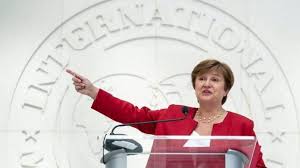Sub-Saharan African governments are paying more to borrow at home than abroad as they turn increasingly to domestic banks to plug financing gaps, deepening risks for lenders and squeezing private investment, the International Monetary Fund said on Thursday. “The domestic cost of capital remains elevated across the region,” the IMF said in its Regional Economic Outlook, which was released during the annual meetings of the global lender and World Bank in Washington. Local financial markets are underdeveloped – characterized by shallow depth, fragmentation, illiquidity and high transaction costs and lending spreads.” The IMF warned that new domestic public borrowing is “significantly more expensive than external borrowing” in many countries. Heavy reliance on banks is raising funding costs further and “crowding out private-sector investment.” Domestic bank holdings of sovereign debt are “large and growing faster in sub-Saharan Africa than in the rest of the world,” it added, creating a “vicious potential feedback loop” in which weakening government finances threaten banks’ soundness, curbing credit and heightening fiscal stress.
Abebe Selassie, at his briefing on Africa said “six months ago, our assessment highlighted the region’s strong policy efforts and that growth had exceeded expectations in 2024. But we also noted a sudden realignment of global priorities and increasingly turbulent external conditions—marked by weaker demand, softer commodity prices, and tighter financial markets. Today, these global headwinds continue to test the region’s recovery and resilience. Sub-Saharan Africa’s economic growth is projected to hold steady at 4.1 percent in 2025, with a modest pickup expected in 2026. This reflects ongoing progress in macroeconomic stabilization and reform efforts across key economies. Several countries—Benin, Côte d’Ivoire, Ethiopia, Rwanda, and Uganda—are among the world’s fastest-growing. However, resource-intensive, and conflict-affected countries continue to face significant challenges, with only modest gains in income per capita.
The external environment remains challenging. Global growth is slowing, and commodity prices are diverging. Oil prices are declining, while prices for cocoa, coffee, copper, and gold remain elevated.
“External financing terms have improved somewhat, allowing a few countries, notably Kenya and Angola most recently, to access international capital markets. The global trade policy and aid landscape has also deteriorated. Tariffs on exports to the United States have increased, and preferential access under the African Growth and Opportunity Act has expired. While the direct exposure is relatively modest for most countries in the region, broader trade policy uncertainty is weighing on growth.
The projected sharp decline in foreign aid leaves several lower-income and fragile economies particularly exposed. Affected governments have sought to reallocate budgetary resources but with limited fiscal space, they have limited room for maneuver. It is encouraging to see the region showing remarkable resilience. Although this will continue to be tested in the coming months. Pressure points include; rising debt service costs, which are crowding out development spending; a shift toward domestic financing that is deepening the sovereign-bank nexus; inflation that has eased at the regional level but remains in double digits in about one-fifth of the region, and; external buffers that are under pressure and need to be rebuilt.
Against this difficult backdrop, our October 2025 Regional Economic There is significant potential for countries in the region to raise revenues through comprehensive tax policy reforms and improved tax administration. This includes modernizing tax systems through digitalization, streamlining inefficient tax expenditures, and strengthening enforcement via targeted compliance strategies. However, these efforts must go beyond technical adjustments. It will be essential to build public trust in tax institutions, strengthen institutional capacity, and conduct careful impact assessments—including distributional analysis—to ensure that reforms are both effective and equitable. Enhancing debt transparency and strengthening public financial management can help reduce borrowing costs and unlock innovative financing. Publishing comprehensive debt data and reinforcing budget oversight are key steps forward.
These priorities are critical for building resilience and supporting inclusive, sustainable growth across sub-Saharan Africa. The IMF remains committed to supporting the region. Since 2020, we have disbursed nearly $69 billion, including about $4 billion so far this year. Our capacity development efforts also remain substantial, with sub-Saharan Africa as the largest recipient.
Abebe Aemro Selassiesaid that the shift to local funding was a double-edged sword. “About half of total public debt is owed to domestic banks,” he said. “Access to external financing has not been readily available in recent years, but it is also a positive sign because, fundamentally, we want countries to be able to borrow in their own currency.” Still, he cautioned that excessive domestic borrowing “can also create problems in the banking sector” if governments struggle to service debt. African countries have been very cautiously returning to international markets since 2024, after many were effectively locked out in 2022 due to a surge in borrowing costs and increased economic risks. The cost of borrowing has fallen from crisis highs, but many governments are still servicing past debts and seeking to avoid new debt traps.
Policymakers are now experimenting with a mix of domestic bond issuance, private placements, and multilateral loans to fund budgets and development projects. Beyond fiscal repair, the IMF called for stronger debt-management frameworks and credible, transparent data to attract long-term investment. It also urged more realistic expectations for “innovative” funding models such as blended-finance vehicles and debt-for-development swaps. Total blended-finance flows to sub-Saharan Africa remain small – about $6 billion per year, the report found. Transactions such as Ivory Coast’s 2024 debt-for-education swap and Gabon’s 2023 debt-for-nature swap are still rare and “comparatively small, typically below $1 billion per year globally.” Selassie said mobilizing private and domestic resources would be vital as aid declines.

